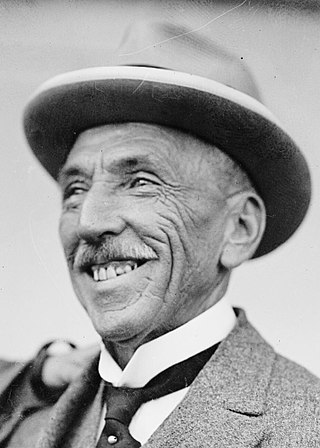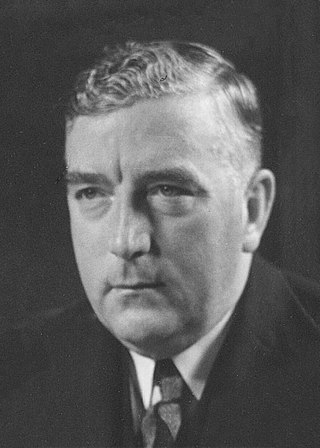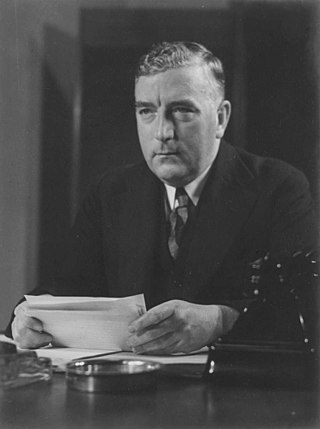
Sir Earle Christmas Grafton Page was an Australian politician and surgeon who served as the 11th prime minister of Australia from 7 to 26 April 1939, in a caretaker capacity following the death of Joseph Lyons. He was the leader of the Country Party from 1921 to 1939, and was the most influential figure in its later years.

Sir Robert Gordon Menzies was an Australian politician and lawyer who served as the 12th prime minister of Australia from 1939 to 1941 and from 1949 to 1966. He held office as the leader of the United Australia Party (UAP) in his first term, and subsequently as the inaugural leader of the Liberal Party of Australia in his second. He was the member of parliament (MP) for the Victorian division of Kooyong from 1934 to 1966. He is the longest-serving prime minister in Australian history.

The United Australia Party (UAP) was an Australian political party that was founded in 1931 and dissolved in 1945. The party won four federal elections in that time, usually governing in coalition with the Country Party. It provided two prime ministers: Joseph Lyons (1932–1939) and Robert Menzies (1939–1941).

The Nationalist Party, also known as the National Party, was an Australian political party. It was formed in February 1917 from a merger between the Liberal Party and the National Labor Party, the latter formed by Prime Minister Billy Hughes and his supporters after the 1916 Labor Party split over World War I conscription. The Nationalist Party was established as a 'united' non-Labor opposition that had remained a political trend once the Labor party established itself in federal politics. The party was in government until electoral defeat in 1929. From that time it was the main opposition to the Labor Party until it merged with pro-Joseph Lyons Labor defectors to form the United Australia Party (UAP) in 1931. The party is a direct ancestor of the Liberal Party of Australia, the main centre-right party in Australia.

Sir John McEwen was an Australian politician and farmer who served as the 18th prime minister of Australia from 1967 to 1968, in a caretaker capacity following the disappearance of prime minister Harold Holt. He was the leader of the Country Party from 1958 to 1971, serving as the inaugural deputy prime minister of Australia from 1968 to 1971.

William Morris Hughes was an Australian politician who served as the seventh prime minister of Australia from 1915 to 1923. He led the nation during World War I, and his influence on national politics spanned several decades. He was a member of the federal parliament from the Federation of Australia in 1901 until his death in 1952, and is the only person to have served as a parliamentarian for more than 50 years. He represented six political parties during his career, leading five, outlasting four, and being expelled from three.

Sir Arthur William Fadden was an Australian politician and accountant who served as the 13th prime minister of Australia from 29 August to 7 October 1941. He held office as the leader of the Country Party from 1940 to 1958 and served as treasurer of Australia from 1940 to 1941 and 1949 to 1958.

Archie Galbraith Cameron was an Australian politician. He was a government minister under Joseph Lyons and Robert Menzies, leader of the Country Party from 1939 to 1940, and finally Speaker of the House of Representatives from 1950 until his death.

The Liberal–National Coalition, commonly known simply as the Coalition or the LNP, is an alliance of centre-right to right-wing political parties that forms one of the two major groupings in Australian federal politics. The two partners in the Coalition are the Liberal Party of Australia and the National Party of Australia. Its main opponent is the Australian Labor Party (ALP); the two forces are often regarded as operating in a two-party system. The Coalition was last in government from 2013 to 2022. The group is led by Peter Dutton, who succeeded Scott Morrison after the 2022 federal election.

The Fadden ministry was the 28th ministry of the Government of Australia. It was led by the country's 13th Prime Minister, Arthur Fadden. The Fadden ministry succeeded the Third Menzies ministry, which dissolved on 28 August 1941 following the resignation of Robert Menzies as Prime Minister. A subsequent joint meeting of the Coalition parties elected Country leader Fadden as Menzies' successor. The ministry was replaced by the First Curtin ministry on 7 October 1941 after the independent crossbenchers Alexander Wilson and Arthur Coles withdrew their support for the Fadden government and voted with John Curtin and his Labor Party to bring the government down in a de facto no-confidence motion.

Sir Percy Claude Spender was an Australian politician, diplomat, and judge. He served in the House of Representatives from 1937 to 1951, including as a cabinet minister under Robert Menzies and Arthur Fadden. He was later Ambassador to the United States (1951–1958) and a member of the International Court of Justice (1958–1967), including as president of the court from 1964 to 1967.

The 1943 Australian federal election was held in Australia on 21 August 1943. All 74 seats in the House of Representatives and 19 of the 36 seats in the Senate were up for election. The incumbent Labor Party, led by Prime Minister John Curtin, defeated the opposition Country–UAP coalition led by Arthur Fadden in a landslide. The Labor party TPP result of 58.2% is its highest, in its history.

The 1940 Australian federal election was held in Australia on 21 September 1940. All 74 seats in the House of Representatives and 19 of the 36 seats in the Senate were up for election. The incumbent Coalition, consisting of the United Australia Party led by Prime Minister Robert Menzies and the Country Party led by Archie Cameron, defeated the opposition Labor Party under John Curtin despite losing the overall popular vote.

Sir Eric John Harrison, was an Australian politician and diplomat. He was the inaugural deputy leader of the Liberal Party (1945–1956), and a government minister under four prime ministers. He was later High Commissioner to the United Kingdom from 1956 to 1964.

Allan McKenzie McDonald, DFC was an Australian politician who served in the House of Representatives from 1940 until his death in 1953. He served as Minister for External Territories in the Menzies and Fadden governments in 1941. McDonald represented the United Australia Party until 1945, when he joined the new Liberal Party. Before entering federal politics he had previously served in the Victorian Legislative Assembly from 1933 to 1940.
This is a list of the members of the Australian House of Representatives in the 17th Australian Parliament, which was elected at the 1943 election on 21 August 1943. The incumbent Australian Labor Party led by Prime Minister of Australia John Curtin defeated the opposition Country Party led by Arthur Fadden with coalition partner the United Australia Party (UAP) led by Billy Hughes. On 21 February 1945, the parliamentary UAP was dissolved and replaced by the newly established Liberal Party.

The Menzies government (1939–1941) refers to the federal executive government of Australia led by Prime Minister Robert Menzies. Menzies led the United Australia Party in the Australian Parliament from 1939 to 1941. Menzies served a later and longer term as prime minister as leader of a successor party, the Liberal Party of Australia from 1949 to 1966.

The Fadden government was the federal executive government of Australia led by Prime Minister Arthur Fadden, as leader of the Country Party. He was appointed prime minister on 29 August 1941, during World War II, following the resignation of Robert Menzies of the United Australia Party (UAP). Fadden continued the coalition government between the Country Party and the UAP, but after just over one month in office the government was defeated on a confidence motion. Fadden was succeeded as prime minister on 7 October 1941 by John Curtin of the Australian Labor Party (ALP).

The United Australia Party (UAP) held a leadership election on 22 September 1943, following the resignation of Billy Hughes. Robert Menzies, the party's leader from 1939 to 1941, was elected as his replacement, defeating three other candidates – Thomas White, Allan McDonald, and Percy Spender.

The Victorian Liberal Party, officially known as the Liberal Party of Australia (Victorian Division) and branded as Liberal Victoria, is the state division of the Liberal Party of Australia in Victoria. It was formed in 1949 as the Liberal and Country Party (LCP) and simplified its name to the Liberal Party in 1965. The party sits on the centre-right to right-wing of the Australian political spectrum, and is currently led by Brad Battin.


















